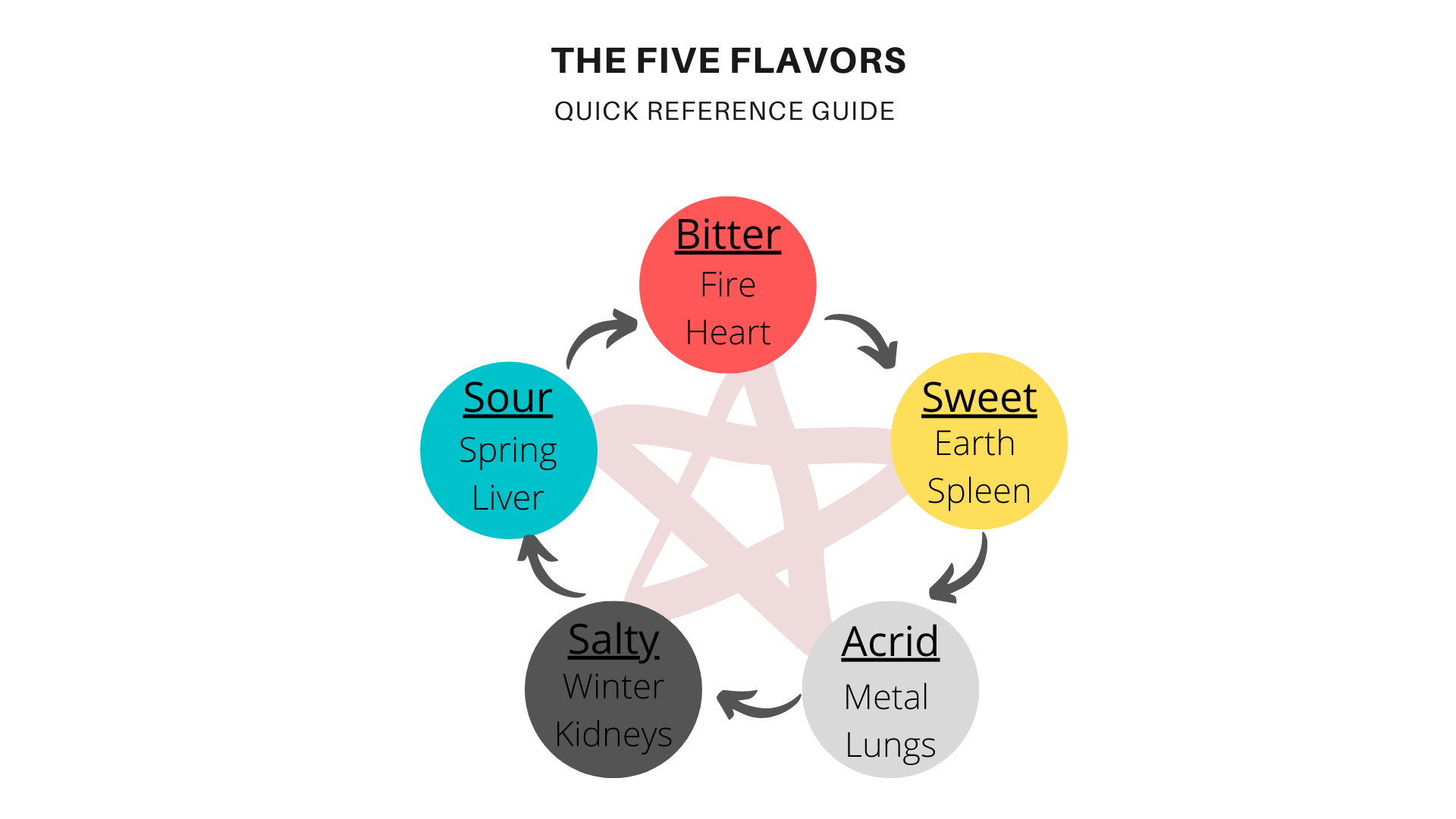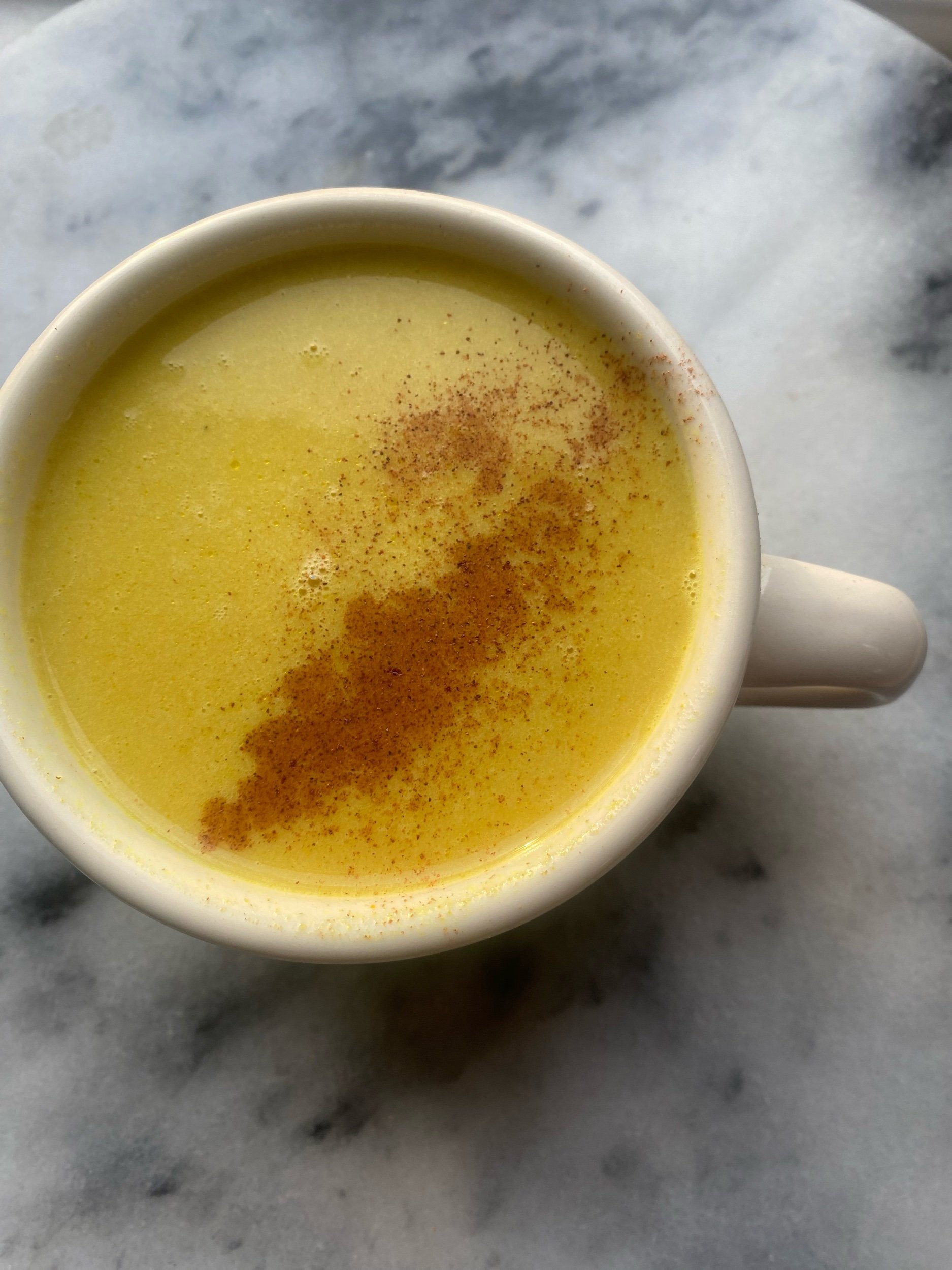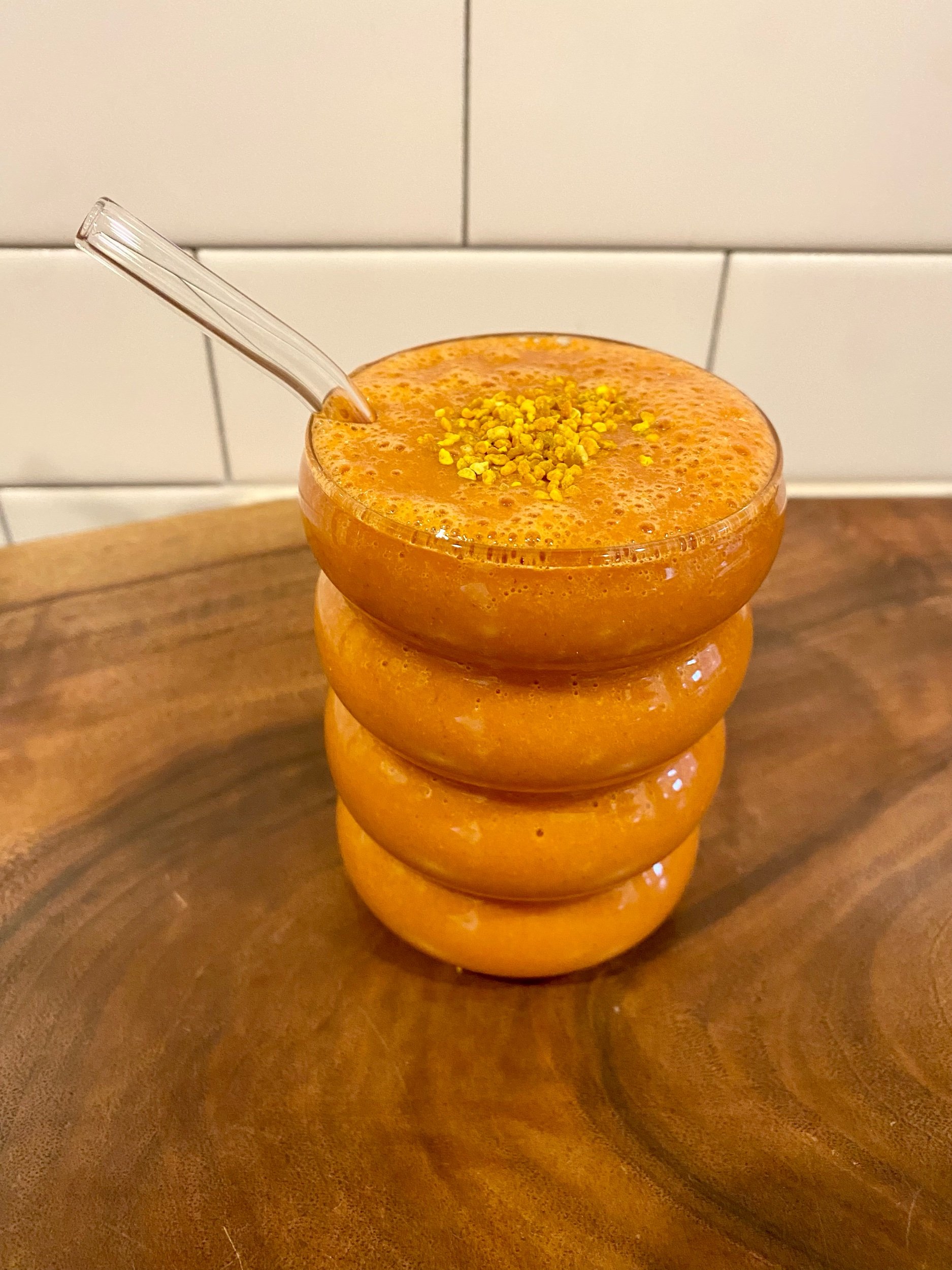Seasonal Eating and Chinese Medicine
Eating with the Seasons
Chinese Medicine Dietary Therapy is such a beautiful, natural, and effective way to help people develop a personalized and healthy diet regimen. This nutritional outlook has a main focus on finding and establishing balance within the body to help achieve optimal health. We are just as much part of nature as the plants and the trees, and when we consider this, we realize that eating in alignment with the seasons will just bring us more in alignment with our bodies.
This idea of eating with the seasons is not only focused upon what is actually in season or currently growing during that time of year but, in true Chinese Medicine fashion, looks deeper at the energetics of the foods and the flavors as they interact with our body’s Organ Systems. Eating foods with flavors that help balance our bodies during particular times of the year and cook in ways that best promote digestive function.
The Five Seasons
Chinese medicine theory has five elements and five seasons. The elements are not only in nature around us, but within us (Fire, Earth, Metal, Water, Wood), and the seasons correspond with each element ( Summer, Later Summer, Autumn, Winter, and Spring respectively). In Chinese medicine theory, the concept of the Five Elements extends beyond its manifestation in the natural world and encompasses an intricate interplay within the human body. The five elements represent fundamental energies that shape both the external environment and internal physiological processes. This perspective acknowledges the dynamic relationship between nature and human health, emphasizing the cyclical and interconnected nature of the elements and seasons. By aligning lifestyle practices, dietary choices, and therapeutic interventions with the changing energies of the seasons, Chinese medicine seeks to promote balance and harmony within the body, fostering optimal well-being throughout the year.
Spring- The Wood Season
During the transition from Winter to Spring, our bodies emerge from a period of dormancy, akin to nature awakening from its winter slumber. Spring marks the revival of Yang Qi, both within our bodies and in the Earth itself. Aligned with the Wood element, this season presents an opportune time for nourishing the Liver and Gallbladder, the organs associated with Wood. Incorporating foods with a sour flavor is particularly beneficial during Spring, as they are believed to support the Wood element and promote liver health. Furthermore, these foods play a role in nurturing the Earth meridians of the Spleen and Stomach, which are associated with the sweet taste. Embracing the essence of Spring by selecting foods attuned to the Wood element not only aligns with the principles of Traditional Chinese Medicine but also reflects a holistic approach to wellness that harmonizes with the natural cycles of the seasons.
Flavor Association- Sour
Spring Cooking- Cook for a shorter time in spring but at a high temperature. Vegetables should not be thoroughly cooked, especially the inner part. When sauteing, or stir-frying, do so quickly over high heat. When cooking with water, steam lightly or simmer minimally.
Summer- The Season of Fire
As we transition into Summer, a season characterized by warmth and increased Yang energy, our bodies and the Earth experience a vibrant surge in vitality. The Summer season corresponds with the Fire element in Chinese medicine, signifying a time of heightened activity and expansion. During this period, it is advisable to focus on foods that help balance the Fire element and support the Heart and Small Intestine, the organs associated with Summer. Embracing a diet rich in bitter flavors can be particularly beneficial during this season, as bitterness is believed to cool the body and disperse excess heat. Additionally, incorporating hydrating foods such as watermelon and cucumbers can help counteract the potential for heat-related imbalances. By aligning dietary choices with the energetic qualities of Summer, one can optimize well-being and promote harmony within the body's internal systems, aligning with the wisdom of Traditional Chinese Medicine.
Flavor Association- Bitter
Summer Cooking- Make brightly colored salads and dishes with a variety of summer fruits and vegetables. Decorate with flowers and cut the vegetables into decorative shapes. Cook lightly and spice up the dishes a little with pungent or fiery flavors. Steam or simmer over high heat for a short time, or saute or stir fry quickly. Use a little salt, more water, and less oil in cooking. Heavy greasy salty food can cause sluggishness this time of year., On the hottest days, cook and eat outside or have a picnic.
Late Summer- The Earth Element
Transitioning from the warmth of Summer to the later part of the season, we enter a phase known as Late Summer in Traditional Chinese Medicine. This season is associated with the Earth element, symbolizing a period of transformation and grounding energy. Late Summer is a unique bridge between the expansive nature of Summer and the contracting energy of Autumn. It is an opportune time to focus on supporting the digestive system, particularly the Spleen and Stomach, which are linked to the Earth element. Foods that are sweet and mildly dampening, such as grains, legumes, and root vegetables, are recommended during Late Summer to nourish and stabilize the Earth energy. This emphasis on Earth-related nourishment aligns with the principles of Chinese medicine, promoting balance and harmony within the body as it transitions through the seasonal cycles.
Flavor Association- Sweet Foods
Late Summer Cooking- Use moderation with a mild taste as a guide to late summer cooking. Avoid making complicated dishes with unusual combinations. The dishes should be simple with little to no seasonings, allowing the natural flavors to shine through. Minimize cooking time and use a moderate amount of salt, oil, and water.
Autumn- The Season of Metal
As Autumn unfolds, signaling a shift towards cooler temperatures and a decrease in Yang energy, Traditional Chinese Medicine associates this season with the Metal element. Autumn is considered a time of refinement and letting go, and it is linked to the Lung and Large Intestine organs. Embracing foods with a pungent flavor becomes particularly relevant during this season, as pungency is believed to have a dispersing quality that can help clear and circulate the Lung Qi. Incorporating pungent foods like garlic, onions, and ginger can support the respiratory system and aid in the body's natural ability to eliminate stagnation. By aligning dietary choices with the energetic qualities of Autumn, individuals can harness the wisdom of Traditional Chinese Medicine to promote respiratory health, embrace the season's transformative nature, and foster overall well-being.
Flavor Association- Pungent Foods
Autumn Cooking- Cook with less eater, at a lower heat, and for a longer time. Use a little salt in cooking to moisten dryness. Heighten the diet with pungent flavors and hearty foods that are sauteed, stir-fried, or baked. Foods like winter squash and roost thicken the blood for cool weather. Eat fewer cold foods such as salads and fruits during the fall. Stew or bake apples and pears. Make cold-pressed salads by blanching green and pressing out the water.
Winter- The Water Season
Entering Winter, a season characterized by coldness and a deepening of Yin energy, Traditional Chinese Medicine associates this period with the Water element. Winter is aligned with the Kidney and Bladder organs, which are essential for storing and balancing the body's vital energy. Incorporating foods with a salty flavor becomes particularly relevant during Winter, as saltiness is believed to have a softening and moistening effect, supporting the Water element. Salty foods like seaweed and fish are recommended to nourish the Kidney and Bladder meridians, promoting fluid balance and the retention of essential energy. By embracing the principles of Winter nourishment and focusing on salty flavors, individuals can align their diets with the energetic qualities of the season, supporting the health of the Kidney and Bladder organs and cultivating resilience during the colder months.
Flavor Association- Salty Foods
Winter Cooking- Cook foods longer, at lower temperatures, and with less water. Make warm hearty soups and steam winter green to fortify the Kidneys. Roasted nuts and baked apples are a great snack on cold days. Ginger is an amazing addition to meals this time of year. Ginger contains a pungent flavor; stimulates blood circulation; warms and relaxes the Kidneys in cold weather and clears the Lungs in the fall.
Eating with the Seasons; The Taste Component
In TCM, the concept of eating with the seasons extends beyond just choosing seasonal produce; it also emphasizes the significance of taste in food selection. Each season is associated with specific tastes that align with the principles of balancing the body's energy and promoting overall well-being. According to TCM, incorporating a variety of tastes in one's diet is essential for maintaining harmony within the body. For example, the sour taste is recommended during spring to help stimulate the Liver and promote detoxification. Summer, associated with heat, benefits from the consumption of bitter foods to cool the body. Pungent tastes, found in autumn-summer produce, are believed to nourish the Lungs and Large Intestine. Salty flavors are associated with winter and can help support the Kidneys. By incorporating these tastes following the seasons, TCM suggests that individuals can support their body's natural cycles and optimize health.
Sour Foods
Sour foods, exemplified by lemons, vinegar, or pineapples, have a distinct taste profile that tends to constrict or consolidate energy within the body. In Traditional Chinese Medicine, the sour taste is associated with the Wood element and is believed to benefit the liver. Consuming sour foods during the spring season is thought to help stimulate the liver's functions, promoting detoxification and a smooth flow of energy. The sour flavor is also considered astringent, contributing to its ability to consolidate and tone bodily tissues.
Resonates with Wood Element
Liver and Gallbladder Meridians
Associated with Springtime
Bitter Foods
Bitter foods, such as collard greens and kale, play a crucial role in promoting appetite and maintaining balance in the body according to Traditional Chinese Medicine. The bitter taste is associated with the Fire element and is believed to clear "dampness" from the body, aiding in digestion and preventing stagnation. Consuming bitter foods is thought to help descend Qi or energy, supporting a smooth flow of vital energy throughout the body. By incorporating bitter flavors, individuals may experience improved digestion, reduced dampness, and a heightened appetite, contributing to overall well-being.
Resonates with Fire Element
Heart and Small Intestine Meridians
Associated with Summer
Sweet Foods
Sweet foods, exemplified by green beans, peanuts, and watermelon, are associated with the Earth element in Traditional Chinese Medicine. Consuming sweet flavors is believed to have a harmonizing effect on the body, promoting balance and stability. These foods are known for enriching the body's fluids, supporting hydration and nourishing bodily tissues. In TCM, the sweet taste is associated with the Spleen and Stomach organs, and incorporating sweet foods is thought to contribute to overall digestive health and well-being. Including a moderate amount of naturally sweet foods can be part of a balanced diet to support bodily functions and promote harmony within the system.
Resonates with Earth Element
Spleen and Stomach Meridians
Associated with Late summer
Spicy and Pungent Foods
Spicy and pungent foods, including ginger, garlic, and wine, are known in Traditional Chinese Medicine for their ability to move and circulate Qi and blood within the body. The pungent taste is associated with the Metal element and is believed to have a dispersing quality, promoting the flow of vital energy. Consuming these foods is thought to invigorate the circulatory system, aiding in improved blood circulation and Qi movement. Additionally, the warming nature of spicy and pungent flavors is considered beneficial for individuals seeking to dispel cold and dampness from the body, supporting overall vitality and well-being.
Resonates with Metal Element
Lung and Large Intestine Meridians
Associated with Autumn
Salty Foods
Salty foods, exemplified by seaweed and clams, play a distinctive role in Traditional Chinese Medicine by softening firm masses within the body. The salty taste is associated with the Water element and is believed to have a softening and moistening effect. Consuming salty foods is thought to attract water that is already present in the body, aiding in the dissolution of accumulations and promoting a smoother flow of bodily fluids. In TCM, this taste is often recommended for individuals with conditions characterized by the formation of hardened masses, such as cysts or nodules. Moderate amounts of naturally salty foods can be considered for their potential therapeutic effects in promoting fluid balance and addressing certain health concerns.
Resonates with Water Element
Kidney and Bladder Meridians
Associated with Winter
Bland-Tasting Foods
A sixth yet important category- Bland-tasting foods, such as lettuce, mushroom, and barley, play a role in TCM in regulating fluids within the body. The bland taste is believed to harmonize bodily fluids and doesn’t have a specific element association. These foods are considered neutral in flavor and can contribute to balancing the body's fluid levels without exerting strong influences on other organ systems. In TCM, incorporating bland-tasting foods is often recommended for individuals seeking to maintain hydration and promote equilibrium within the digestive system. Including a variety of these neutral flavors in one's diet may contribute to overall fluid balance and support optimal well-being.
Seasonal Eating Tips
By integrating these tips into your approach to seasonal eating, you can enhance your overall nutrition, support your body's natural rhythms, and promote a sense of balance and vitality throughout the changing seasons.
Embrace a Rainbow of Colors
Incorporate a variety of colorful fruits and vegetables into your diet, as different colors often signify diverse nutrient profiles. This can provide a broad spectrum of vitamins, minerals, and antioxidants, contributing to overall health and well-being.
Mindful Cooking Methods
Adjust your cooking methods based on the season. Opt for lighter, cooling cooking techniques like steaming and sautéing during warmer months and explore heartier, warming methods like roasting and stewing in colder seasons. This aligns with your body's natural needs throughout the year.
Hydration with Seasonal Beverages
Stay hydrated with beverages that complement the season. In summer, opt for refreshing herbal teas and infused water, while in winter, consider warming herbal teas and broths to provide comfort and support immunity.
Local and Sustainable Choices
Choose locally sourced and sustainable foods whenever possible. This not only supports local farmers but also ensures that you are consuming foods that are more attuned to the specific environmental conditions of your region.
Listen to Your Body
Pay attention to your body's signals and cravings. Seasonal eating is not one-size-fits-all, and individual needs may vary. Tune in to what your body is asking for, and make adjustments accordingly to maintain a harmonious balance.
Seasonal Superfoods
Explore superfoods that are in season. These nutrient-dense foods, aligned with the current season, can provide a concentrated source of essential nutrients, offering a natural boost to your overall health.
Incorporate Traditional Wisdom
Draw upon the wisdom of traditional cuisines and practices. Many cultures have time-tested approaches to seasonal eating, incorporating local ingredients and traditional flavors that are well-suited to specific times of the year.




























🔥 Your Guide to Safely Practicing Moxa at Home 🔥
Curious about moxa but not sure where to start? This easy, step-by-step guide will show you how to safely use moxibustion at home to ease pain, warm your body, support energy, and especially boost digestive function.
Perfect for beginners and seasoned wellness lovers alike, it’s packed with practical tips, clear instructions, and everything you need to feel confident and cared for. This guide is focused on using premade moxa poles, especially for digestive health and pain relief.
✨ Simple. Soothing. Rooted in tradition.
👉 Download now and light up your self-care routine with the warmth of tradition!